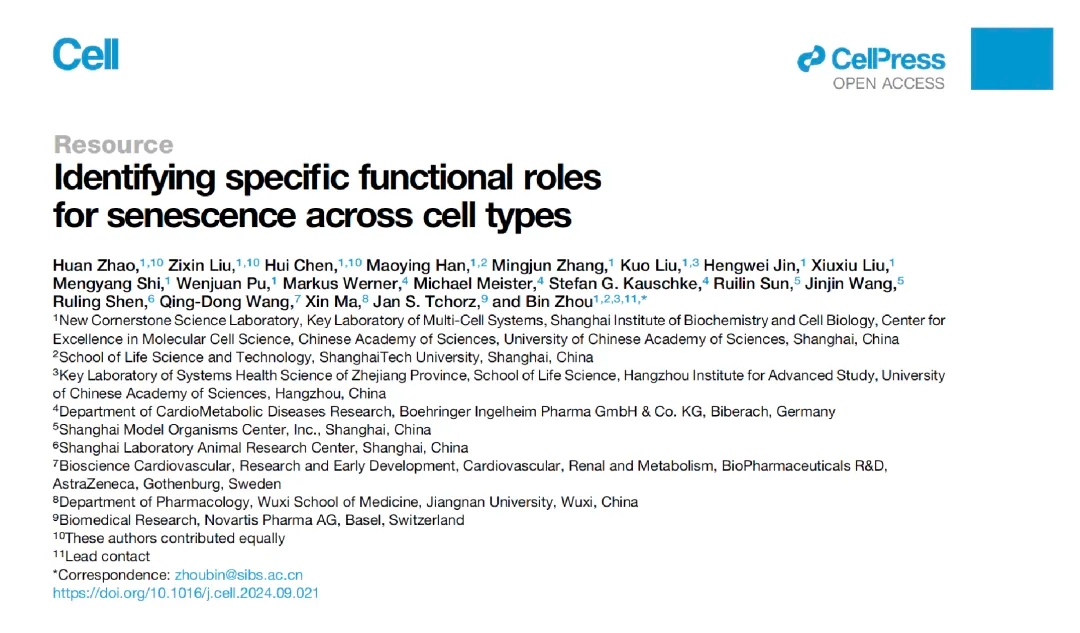
Researchers equipped with these technologies resemble Sun Wukong with his “Fiery Golden Eyes.”
Cellular aging is associated with body aging and many diseases. However, research on cellular aging has lacked precision because researchers have been unable to accurately “snipe” specific types of senescent cells, limiting their ability to track all aging cells collectively. We now understand that liver fibrosis is also related to cellular aging.

All images in this article are sourced from the WeChat public account @Chinese Academy of Sciences Molecular Cell Excellence Center
On October 7, The Paper received word from the Chinese Academy of Sciences’ Molecular Cell Science Excellence Innovation Center (Institute of Biochemistry and Cell Biology) that the Zhou Bin research group has recently published a paper titled “Identifying Specific Functional Roles for Senescence Across Cell Types” in the international academic journal Cell.

Various cell types express tdT in p16-tdT mice with senescence
The Zhou Bin research group has developed innovative methodologies to precisely track senescent cells of specific types. Through studies on mouse models, they found that cellular aging in liver fibrosis is primarily related to two cell types—macrophages and endothelial cells. They also confirmed for the first time that the exacerbation of liver fibrosis is due to the burdensome and harmful actions of senescent macrophages. Clearing these specific cells can improve liver fibrosis, providing potential insights and theoretical grounds for related clinical applications.
In short, the Zhou Bin research group has invented a universal research method and associated animal models to tackle the aforementioned scientific issues, making their new approach more precise and allowing for greater imaginative potential.
Associate Researcher Zhao Huan is one of the three co-first authors of the paper. She told The Paper that the newly published study reports on four new systems that establish a technique for in vivo tracking of senescent cell lineages and researching their specific functions. “We can share the tool mice with other scientists so they can study other types of aging cells,” she explained. “For example, previous studies in neurodegenerative disease models found an increase in senescent astrocytes and microglia in the brain, and clearing out the aging cell group improved the disease. With our toolkit, we can precisely study the aging glial cells in their brains.”
Cellular senescence refers to the process where a cell's ability to proliferate, differentiate, and maintain its physiological functions declines over time. Additionally, various persistent cellular stresses can induce cellular senescence, such as the accumulation of DNA damage, activation of oncogenes, loss of tumor suppressor genes, and exposure to reactive oxygen species.
Although it is a normal metabolic process, both body aging and many diseases are associated with cellular aging.
Understanding the details of cellular aging at different scales or levels and even reversing the senescence process for specified cells is a dream for many scientists.
If senescent cells were likened to potential criminals, tracking these cells could be compared to “hunting for a perpetrator.” However, due to the lack of suitable research methods and tools, it has been difficult for scientists to “track suspects”—unable to follow specific senescent cells, nor to clearly understand “where they come from, where they go, and what they aim to do.”
Complicating matters further, senescent cells can be adjacent to newly born cells, adding to the challenges of real-world research. Moreover, studies have shown that senescent cells may play positive roles in certain situations, such as tumor suppression, embryonic development, wound healing, hair growth, and facilitating lung regeneration.
Currently, it is estimated that the human body contains about 30 trillion cells, comprising over 400 different cell types: adult males approximately 36 trillion cells, adult females about 28 trillion cells, and children around 17 trillion cells. Tracking “suspects” among such a vast number of cells is quite challenging.
However, lineage tracing of cells is a strong suit of the Zhou Bin research group. Previously, researchers have used “exogenous labeling,” such as fluorescent dyes, to track cells. Still, as cells continually divide and proliferate, the fluorescence can become too diluted or metabolized, ultimately rendering tracking impossible.
In contrast, the Zhou Bin research group utilized a powerful tool—genetic lineage tracing. This technique employs gene targeting methods to create transgenic mice, incorporating recombinant enzyme genes with specific promoters into the cell genome. After mating with mice carrying reporter genes, this methodology ultimately enables lineage tracking of specific cells in offspring through homologous recombination technology.
Traditional technologies often utilized the “Cre-loxP” system for singular homologous recombination, which has limitations, especially regarding non-specific labeling. The Zhou Bin research group has added a new layer to the traditional lineage tracing system with a second system—Dre-rox, effectively creating double conditional conditions. They established a series of new dual homologous recombination reporter systems that can simultaneously label and track two or three distinct cell populations, resulting in more precise tracing outcomes, thus offering new technological options for research on development, disease, and regeneration.

The Zhou Bin research team
To illustrate, Zhou Bin likens their system to a classroom of 30 students. If they want to find students that meet specific criteria, the traditional single homologous recombination enzyme system only sets one condition, like “long hair.” In contrast, dual homologous recombination introduces two specific criteria, such as “long hair” and “wearing glasses,” leading to more accurate results.
In recent years, the Zhou Bin research group has used lineage tracing technology to reveal the developmental origins of coronary arteries and has demonstrated the absence of endogenous cardiac stem cells capable of forming cardiomyocytes in adult hearts. They have explored the origins of liver vasculature and identified the primary regions from which newly formed liver cells originate in adult livers.
Zhao Huan noted to The Paper that through the dual homologous recombination system, they have been able to track senescent cells of specific cell types in vivo, discovering their fates and revealing their functions. Because the genetic tracing technology acts at the DNA level, the marked target cells will retain the fluorescent marker gene, regardless of whether they divide into two cells or differentiate into other types, including all their progeny. Moreover, researchers can perform genetic manipulations on specific types of cells, such as gene knockout, overexpression, or cell clearance.
Zhao Huan mentioned that at the genomic level, p16Ink4a is one of the most widely used markers for cell senescence research. It is a cyclin-dependent kinase (CDK) inhibitor protein. “If we construct p16Ink4a Cre or Dre mice, we can ‘capture’ all senescent cells in their body, but it cannot achieve cell type specificity. We’ve combined two systems to establish a dual homologous recombination system. Simply put, I can use a Cre homologous recombination enzyme to identify senescent cells and then utilize a Dre homologous recombination enzyme to limit the cell type, such as macrophages. The intersection of these two gives us senescent macrophages. With these two limits, we can perform more precise genetic operations on them, such as tracking or clearing.”
Zhao Huan indicated that in addition to studying the liver, they extensively research other vital organs like the heart and lungs. “Our lab is also developing genetic manipulation techniques for neighboring cells, investigating the microenvironment of senescent cells, such as how they interact with surrounding neighboring cells; then we aim to regulate these senescent cells or environmental cells to promote damage repair and tissue regeneration.”


